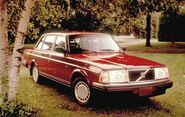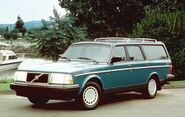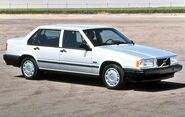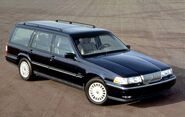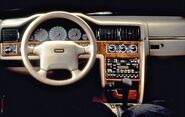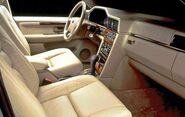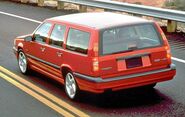Volvo 240
1991
As of the beginning of the '90s, there were three models for the Volvo 240 -- a 4-door sedan, and two models for the 4-door station wagon (base and SE). The SE wagon contained special alloy wheels, all-black grille and trim.
1992
The SE wagon was removed from the lineup after only being available for a limited time, and brand-new for 1992 was a GL 4-door sedan, exclusively made in the U.S. market, also only for a limited time.
1993
With now just the base 4-door sedan and station wagon as the only two models for 1993, this would be the last year for the 240.
Volvo 740
1991
The 700 Series, only available as the 740 in the United States, was sold as a 4-door sedan or 4-door station wagon. Three models were sold for both -- base, Turbo and SE Turbo.
1992
In its last model year, the Volvo 740 only had one model for the 4-door sedan (base), and three new models for the 4-door station wagon (base, GL and GL Turbo). The last 1992 Volvo 740s ended sales in 1993.
Volvo 940
1991
Six trims were made for the Volvo 940 in the beginning of the 1990s; three each for the 4-door sedan and station wagon: GLE, Turbo and SE Turbo.
1992
The lineup dramatically changed for 1992. The GLE and SE Turbo were removed, and a new GL was introduced.
1993
New antitheft stereos were added, along with integrated child safety seats for the station wagons.
1994
Since the elimination of the 240 for the 1994 model year, the 940 was Volvo's entry-level car, with prices starting close to $24,000 at that time. Basically the same as the old rear-drive 700-series cars, the 940 was available with the 2.3-liter iron-block 2-valve- per-cylinder Four, both normally aspirated and turbocharged, in both a sedan and wagon version. The 940 was priced against the upper end of the Toyota Camry 2.5-liter V6 range, the midpoint of Chrysler's LH cars with the 3.5-liter V6, the Nissan Maxima 3.0-liter V6, the VW Passat GLX with its unusual narrow-angle 2.8-liter V6 and some models of Saab's new 900, just to mix a bag.
Tough competition, every one of the preceding models was newer and many had more standard equipment than the basic Volvo. Still, Volvo had a reputation for safety and durability that was near gospel for the Volvo faithful. The boxy looked guarantee a spacious interior and trunk. Upright styling means excellent visibility and low solar heat gain, but also higher wind noise than the competition. The 940 had the traditional Volvo tight turning circle, predictable handling and excellent seats.
It's possible that Volvo eventually made some of the same changes to the 940 that have been made to the 960, revised front suspension, stiffer body/chassis structure, and a 4-cylinder version of the aluminum 5- and 6-cylinder engines used in the 850 and 960 models.
1995
The Level I and Level II trims were totally replaced by new (and less confusing) base and Turbo 4-door sedans and station wagons. Although no one at Volvo commented, the 940 was discontinued like the 240 late in 1995 and was replaced by the new product of a Volvo-Mitsubishi collaboration.
Volvo 960
Since 1992, the 960 was Volvo's top-of-the-line model. The car had much in common with the Mercedes-Benz E300, Lexus ES 300, BMW 325i/530i, and Saab 9000. Although it may not have been readily apparent to any but the Volvo acolyte, the 960 was really quite a different car from its predecessors.
1992
The 960 was introduced on August 12, 1991 as a 1992 model, and as a 4-door sedan and station wagon.
1993
A new passenger airbag, integrated child seats for the wagon, an anti-theft feature, and CFC-free air conditioning were added for 1993.
1994
The trim levels for the 1994 model year were temporarily different compared to the other model years. The sedan was available in Level I and Level II trim levels, and the wagon was only available as a Level II.
1995
The first 1995 Volvo 960 was built on June 27, 1994.
Basic dimensions remained the same, both inside and out, but the body/chassis structure was considerably reengineered. Front suspension was now similar to the front-drive 850 model's, a tubular crossmember was used stiffen the chassis and transverse A-arms put side loads directly into it.
In the rear, the excellent Volvo multilink suspension was now carried on a huge aluminum crossmember. The former coil springs were replaced by a reflex-curved glass fiber transverse leaf. For the first time, the multilink rear setup was used on the wagon as well.
The 2.9-liter aluminum 4-valve inline Six actually lost 20 horsepower compared with 1994, but made its peak power and torque (up by 2 ft.-lb.) at substantially lower speeds. The only transmission was an Aisan-Warner 4-speed, electronically controlled 3-mode automatic with lockup torque converter.
All front and rear body sheetmetal was new for 1995. As a result, the sedan's aerodynamic drag coefficient was reduced from 0.34 to 0.32. Burled walnut trim, most un-Volvolike, was new as are, surprise!, cup holders. Side-impact protection, already in advance of federal requirements, was improved. All seat positions had 3-point harnesses. Dual airbags, climate control and leather upholstery were all standard.
1996
For 1996, the 960 was equipped with front seat side-impact airbags and a multistep power door locking system.
1997
Although 1997 was the last model year for the Volvo 960, production continued through February 5, 1998.
Volvo 850
As a replacement for the Volvo 740, Volvo's front-drive 850 was available as either a 4-door sedan or station wagon. The 850 was Volvo's midpriced car, and competed with such sports/ luxury imports as the Acura Legend, Audi 100, BMW 3-series, Saab 900 and Mercedes-Benz 190-Class (later the C-Class).
1993
The original 1993 models were introduced in late October 1992. Only available as a 4-door sedan in GLT and GLTS trim levels, the 850 featured a 2.4-liter 5-cylinder engine and 5-speed manual transmission, and 168 horsepower.
1994
A new GLTS 4-door station wagon was introduced for 1994, as well as new Turbo models for both the sedan and wagon. The Turbo was the most powerful engine ever offered in a Volvo passenger car, at 222 hp. For this, the wagon got an un-Volvolike top speed of over 150 mph. Turbo models were now fitted with SIPS, Volvo's acronym for Side Impact Protection System, a clever seat-mounted airbag system that, combined with Volvo's outstanding structural side-impact protection, would put them far ahead of U.S. standards.
The Volvo 850 combined a compact, 4-valves-per-cylinder, aluminum 5-cylinder engine (designed in collaboration with Porsche) and optional turbocharger with an equally compact 4-speed, electronically controlled 3- mode automatic transmission. The automatic was standard on Turbo models and optional on others, where a 5-speed manual was standard.
1995
For 1995, the normally aspirated GLT models received smoother front sheetmetal first introduced on Turbo models.
Volvo brought daytime driving lights, required in Sweden and Canada, to the United States on all models. Low wattage was supplied to the headlights whenever the ignition was on. An optional, dealer-installed third seat for children was available on wagons.
Volvo pioneered roadside assistance with its On Call 24-hour roadside service. The 850 had standard airbags, ABS, CFC-free air conditioning and asbestos-free brake pads.
A new all-wheel-drive version of the sedan and wagon, the limited-time-only T-5R, with 240 horsepower, was introduced on March 8, 1995, several months after the base, GLT and Turbo models.
1996
Now that the 940 has been pastured, the 850 has become the entry-level Volvo. Arguably the most heralded introduction in Volvo history, the 850 has come up, spun around and continued outward in several different directions in just three years of production. The amazing T5-R, introduced only last March, was a specially equipped version of the already hot 850 Turbo fitted with startling 17-in. wheels, lowered sport suspension, traction control, 240 hp and exclusive trim and paint. A mere 1000 units later (U.S. allocation), the T5-R is a fleeting memory.
In its place for 1996, a less sanguinary offering called the Platinum Limited Edition. It retains most of the T5-R's content (sport suspension, traction control, special 16-in. tires and wheels, Cold Weather package, keyless entry, sunroof and an upscale AM/FM/cassette/CD stereo and leather upholstery), but not the engine enhancement or the big graphite-colored wheels. Those who wish to upgrade the 850 Turbo should investigate the T5-R parts schedule while it lasts. Other than the platinum, champagne and metallic red paints that are new for 1996, the lineup is unchanged. The sedan and wagon are available in base, GLT and Turbo trim. Aside from Volvo's normal array of safety equipment, all 850 Turbos are fitted with seat-mounted, side-impact airbags designed to minimize body trauma on the rebound (or reaction) side of impact. These SIPS (side-impact protection system) bags are available on nonturbo cars as a $500 option.
The 850 excels in wintry weather. With a cleated tire at each corner, a transmission programmed to start off in third gear and Tracs traction control, the 850 pulls straight ahead in the snow with more confidence than some SUVs. The front-drive 850 competes with the Acura TL, Audi A6, Ford Taurus and Saab 900, as well as the rear-drive BMW 3-series and Mercedes-Benz C-Class.
